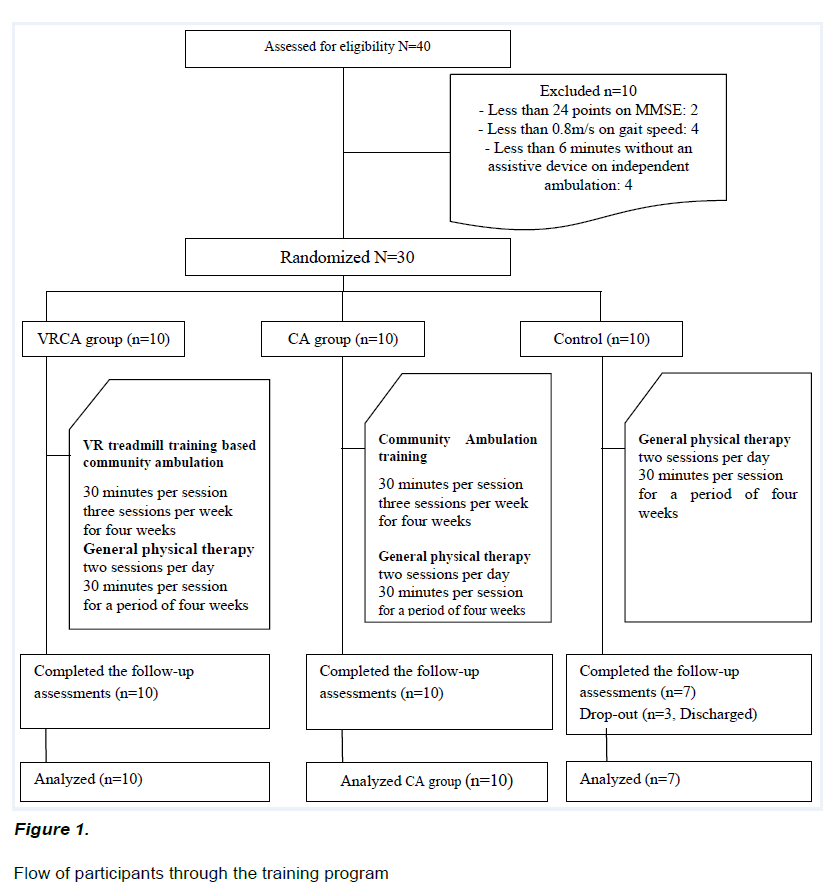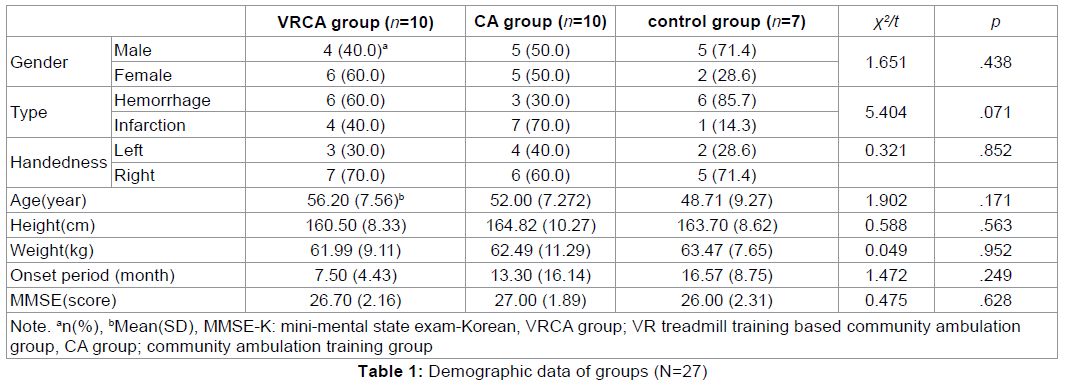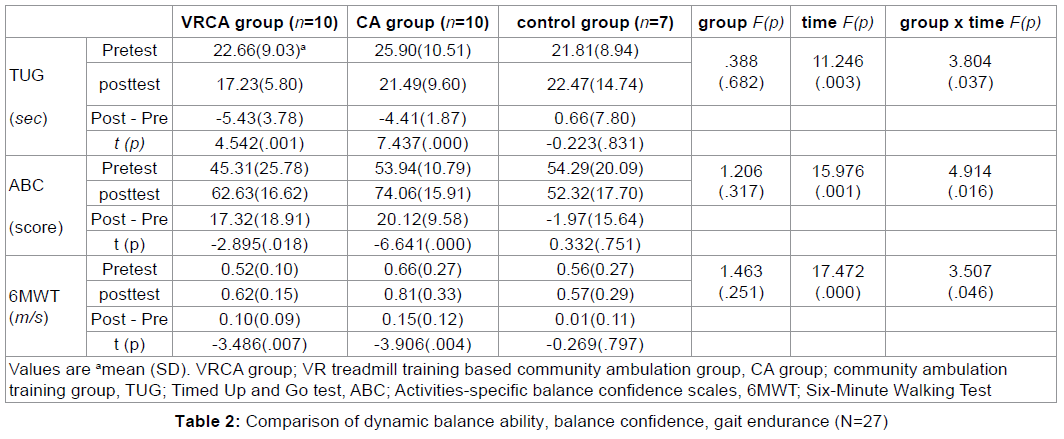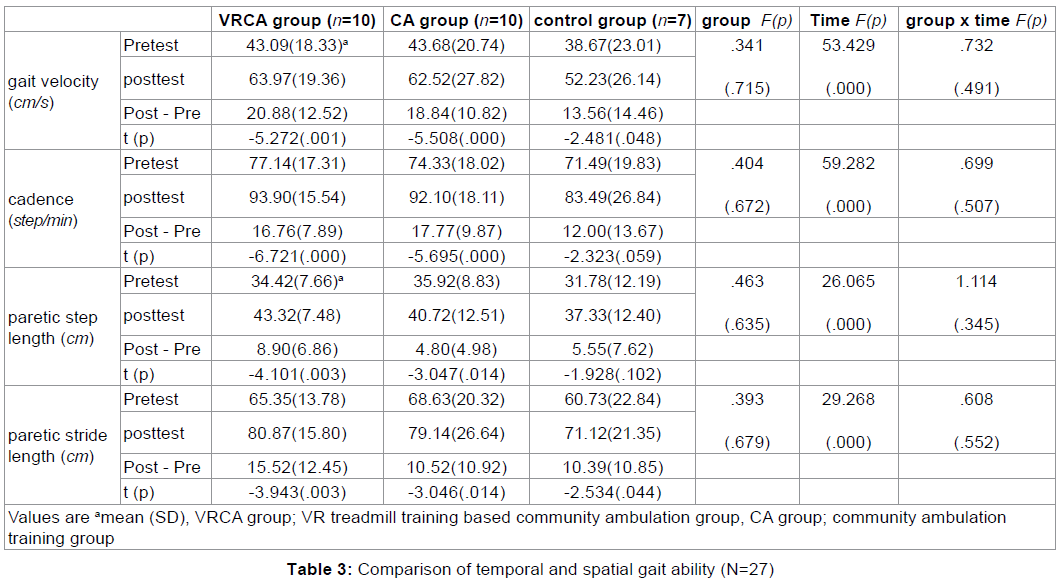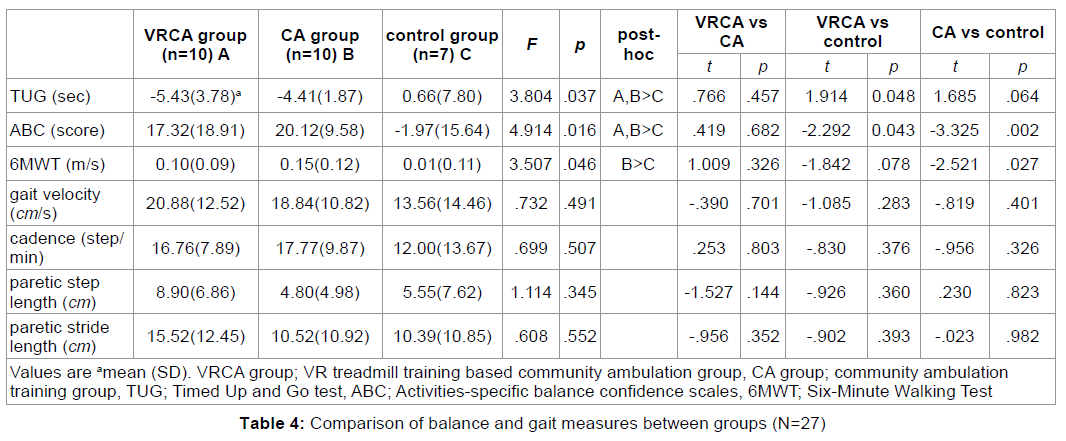Research Article - Journal of Experimental Stroke & Translational Medicine (2016) Volume 9, Issue 1
Effects of Virtual Reality Treadmill Training on Community Balance Confidence and Gait in People Post-Stroke: a randomized controlled trial
- *Corresponding Author:
- ByoungHee Lee
Dept.of Physical Therapy, Sahmyook University
815 Hwarang-ro, Nowon-gu, Seoul
139-742, Republic of Korea
Tel: 82-2-3399-1634
Fax: 82-2-3399-1639
E-mail: 3679@syu.ac.kr
Published Date: January 23, 2016
Citation: Nara Kim, ByoungHee Lee, Yumi Kim, Wonkyu Min. Effects of Virtual Reality Treadmill Training on Community Balance Confidence and Gait in People Post-Stroke: a randomized controlled trial. J Exp Stroke Transl Med. 2016 January. Online access at www.jestm.com
Abstract
Background: This study investigated therapeutic effects of virtual reality (VR) treadmill training has a positive influence on community balance confidence, and gait ability in patients with stroke.
Methods: This was a hospital-based, randomized controlled trial with a blinded assessor. 27 participants with a first-time stroke were randomly allocated to 1 of 3 groups: VR treadmill training based community ambulation group (VRCA group, n=10), Community Ambulation training group (CA group, n=10), and control group (n=7). Group assignment were placed in envelopes and sealed. Each individual who agree to enter the study randomly selected an envelope with the group assignment enclosed. VRCA group received community based VR on treadmill training. CA group received community based ambulation training. All participants included control group were offered physical therapy. Measurements of balance confidence and gait ability were performed.
Results: The results showed that repeated-measures ANOVA revealed significant differences on time effect and time-by-group interaction among groups on TUG, ABC, and 6MWT. ANOVA showed a significant difference in each group about time (Pre-posttest) in gait velocity, cadence, paretic step length and paretic stride length (p< 001), and there was no significant difference on time-by-group interaction.
Conclusion: These results suggest that VR treadmill training based community ambulation and CA training are feasible and beneficial for improvement of community ambulation in poor community ambulatory with stroke.
Keywords
stroke; virtual reality; balance; gait
Background
Stroke has various symptoms according to region of brain invasion. The loss of postural control is a critical deficit following stroke. In particular, patients with stroke results in short stride length, decreased gait speed, and increased single support time on the nonparetic side [Tokuno CD et al. 2006]. In general, gait ability has been recovered within 12 weeks of post stroke; however, gait speed or endurance was decreased because of incomplete recovery [Ada L et al. 2009].
The International Classification of Functioning Disability, and Health (ICF) describes an interaction of physical, social, and environmental factors with an individual's health conditions that produces outcomes of interest for physical therapists [Salbach NM et al. 2001]. Previous research indicates that community ambulation training can improve walking ability in people living in the community after stroke. However, there was no evidence to support successful gait in a real environment because of insufficient reflection of community environmental factors in a clinic [Park HJ et al. 2011].
Biomechanical constraints, movement strategies, sensory strategies, orientation in space, control of dynamics, and cognitive processing are all required for postural stability and orientation [Pluchino A et al. 2012]. Rehabilitation training in a clinic has some limitations such as the use of repeated intense strength, sensory integration, and anticipation of effects on activities of daily living. A recent advance in rehabilitation has been the use of Virtual Reality (VR) [van den Heuvel MR et al. 2013, Kim IC et al. 2012 , Jung GU et al. 2013]. VR uses simulation technology to create a graphic display with sounds and/or voices to engage a person in a scenario in which they play a role. Some amount of closed-loop feedback on the person's performance is generally included. VR can provide a person with the sensation of walking through a world in which there is a goal, encouragement, and a sense of accomplishment. The person can have the “experience” of walking down a city street, through a park, or down the aisles of a grocery store while remaining on a treadmill in a safe, supervised environment [Walker ML et al. 2010]. The inclusion of feedback increases the patient’s involvement in the exercise, and this may lead to better retention [Cameirão MS et al. 2012]. For example, it has been observed that the inclusion of auditory feedback improves the clinical outcomes after rehabilitation with robotic therapy systems [Secoli R et al. 2011].
Currently, attempts are being made to evaluate community ambulation using well-defined outcome measures, and gait speed is a reliable and objective measure of recovery of walking ability and walking performance [Salbach NM et al. 2001]. In addition, gait speed has been found to be the most sensitive parameter for use in objectifying change [Kollen B et al. 2006] and has often been established as the most pronounced marker to show the effects in intervention trials to improve walking competency [Park HJ et al. 2011].
There is some evidence that VR based treadmill training is more effective than treadmill training alone for improvement of stroke patients’ gait ability [Yang YR et al. 2004]. Participants with stroke showed benefits to exercise with VR that offered simulated environment. Jaffe et al [Jaffe DL et al. 2004] studied a group of subjects who were, on average, more than 3 years poststroke. Subjects who completed VR with treadmill training for stepping over objects obtained faster overground gait speed improvement than those who trained by stepping over real objects. Mirelman et al [Mirelman A et al. 2009] studied the effect of an ankle exercise intervention program with or without VR in chronic stroke patients. Subjects in the VRCA group performed their exercises in game format, using ankle movements to steer a plane or boat through a virtual environment in which there were targets. They made significantly greater improvements in overground walking speed and distance compared with the group that simply exercised without VR. You et al [You SH et al. 2005] found improvements in locomotion and motor assessment scores, compared with control subjects, in 5 subjects with chronic stroke (>1y) after training with a VR system that included stepping up and down, dodging virtual sharks, and snowboarding.
However, only a few studies for comparison with community ambulation training in the real world have been reported. Therefore, the purpose of this study was to compare the effects of VR treadmill training based community ambulation (VRCA) versus group gait training on ambulatory ability, balance confidence, and gait pattern of people post-stroke.
Methods
Subjects
Forty patients with first-time stroke were recruited for this study, which was conducted at R hospital in Seoul. Inclusion criteria were as follows: 1) hemiplegia patients over six months after stroke, 2) gait speed of less than 0.8m/s [Botner EM et al. 2009], 3) independent ambulation of more than 6 minutes without an assistive device, 4) Mini-Mental State Examination-Korean (MMSE-K) of more than 24 points. All participants were examined to investigate characteristics regarding their medical history, and orthopedic or neurological status. After checking the selection criteria by a blinded clinical researcher, ten patients were not included because did not satisfy the selection criteria (Figure 1). This study was conducted using a pretest-posttest design with a single-blind randomized control trail. Clinical measures were assessed at baseline and at a 4-week reassessment. The present study was approved by Sahmyook University Institutional Review Boards and each subject was able to follow instructions and gave informed consent by signing an approved consent form; thus, the rights of human subjects were protected.
Experimental procedures
Before starting the experiment, all participants received an examination in order to investigate characteristics regarding history, and orthopedic or neurological examination. Thirty minutes prior to the start of the intervention, the subjects were randomly assigned to among three groups: VR treadmill training based community ambulation group (VRCA group, n=10), Community Ambulation training group (CA group, n=10), and control group (n=10). Group assignment were placed in envelopes and sealed. Each individual who agree to enter the study randomly selected an envelope with the group assignment enclosed.
Participants in the VRCA group received VR treadmill training based community ambulation 12 scheduled sessions, 3 sessions per week. Each session lasted 30 minutes and included rest periods as needed. The CA group received community ambulation training for 3 times 30-minute sessions per week for 4 weeks. The control group received the general exercise program for ten 30-minute sessions per week for 4weeks. Three participants in the control group withdrew during the process of study due to discharge. All experimental procedures are shown in (Figure 1).
InterventionParticipants in the VRCA group were provided with VR computer-stimulated environments to train balance and community ambulation using audiovisual expression technique, audiovisual model, or cognitive information as feedback. Equipment included a VR program, laptop, treadmill with slope controller (WNT-2000i, Wellness strack, Korea, 2009), beam projector (PLC-XW55, Sanyo, Japan), and screen for VR computer-simulated environments.
The VR program was able to control optical flow speed for a participant. VR was projected onto a screen with a width of 2100 mm and a height of 1800 mm through a beam projector with high resolution 1024x768 XGA. The screen was placed 3 m in front of the treadmill. Speed on a VR computer-simulated environment was changed with a keyboard to increase participant’s speed.
The participants stably walked 10 m per trial. The speed on the VR program with treadmill was determined by the mean value of three trials. If the subject maintained the speed and felt safe for 20 s, the treadmill speed was then increased by 5% during next training session [Yang YR et al. 2004].
Participants walked on the treadmill for 5 minutes under each of the following 4 VR conditions - sidewalk walking, overground walking, uphill walking, and stepping over obstacles - with 2-minute rest intervals between conditions. All participants wore a gait belt for their safety. According to their need, participants held a safety bar during training or used ankle orthosis [Yang YR et al. 2004]. The intervention was applied for 30 minutes per session, three times per week for four weeks.
Community ambulation (CA) training consisted of overground walking, stair walking, slope walking, and unstable surface walking of 570 m. An assistant helped to ensure the participant's safety on the paralyzed side. The training was performed for 30 minutes per session, three times per week for four weeks. Rest breaks were provided in the event of participant fatigue.
All participants included the control group were offered usual physical therapy for ten 30-minute sessions per week for 4weeks. Usual physical therapy exercise program was conducted by a physical therapist, consisting of anteroposterior walking on the paretic/nonparetic side, and stair walking training [Park HJ et al. 2011].
Outcome measurements
TUG test was used for testing of dynamic balance ability [McDonough AL et al. 2001]. Research has shown the TUG has excellent interrater (intraclass correlation coefficient, ICC= 98) and intrarater reliability (ICC = 99). Mean value after measuring three times with a stopwatch was recorded, and participants rested for two minutes between trials. During the test, participants were expected to wear their regular footwear and did not use any mobility aids. Balance confidence of community ambulation was measured using ABC. The ABC is a scale with 16 activities that quantifies an individual’s perceived capabilities (self-efficacy) in balance function and provides an inverse measure of perceived fear of falling. The ABC has been found to have excellent reliability (test-retest reliability: ICC 0.85; 95% CI: 0.68– 0.93) between two sessions 1 month apart in individuals with chronic stroke [Botner EM et al. 2009]. 6MWT has been used to evaluate gait endurance in clinical settings [Straudi S et al. 2009]. Subjects were asked to cover as much distance as possible in a 6-minute period walking at a self-selected speed. GAITRite (CIR system Inc, USA, 2008) was used to measure spatio-temporal gait ability for collection of quantitative data while each patient was walking. Mean value after three times repeated measures was recorded, participants rested for two minutes between trials in order to minimize fatigue. This test has both interrater (intraclass correlation coefficient, ICC= 90) and intrarater reliability (ICC = 96) [McDonough AL et al. 2001].
Statistical analysis
All statistical analyses were performed using SPSS 17.0. The Shapiro-Wilk test for normality was used [Shapiro SS et al. 2013]. χ2 test was used for binary variables, and one way ANOVA was used for homogeneity testing among the three groups. The interaction effect between group and time was assessed by using two-way repeated-measures analysis of variance. Paired sample t test were used for assessment of differences between pre-testing and post-testing sessions. Independent t test were used for assessment of between group (VRCA vs CA, VRCA vs control, CA vs control) changes. A P value of less than 0.05 was considered statistically significant.
Results
General characteristics of the remaining 27 participants with stroke who fulfilled the inclusion criteria for the study are summarized in (Table 1). As shown in (Table 1), χ2 results that there were no difference among groups.
The repeated ANOVA results are presented in (Table 2). There was a significant time effect for TUG (F=11.246, p=.003), ABC (F=15.976, p=.001), and 6MWT (F= 7.472, p= 000). The group x time interaction effect for these variables was also significant (TUG: F=3.804, p= 037; ABC: F=4.914, p= 016; 6MWT: F=3.507, p= 046). According to the pre-posttest intragroup, VRCA group and CA group significantly improved in TUG (VRCA: p= 001, CA: p= 000), ABC (VRCA: p= 018, CA: p= 000), and 6MWT (VRCA: p= 007, CA: p= 004) after training, whereas the control group showed no significant change over time.
For gait ability, there was a significant time effect on gait velocity (F=53.429, p= 000), cadence (F=59.282, p= 000), paretic step length (F=26.065, p= 000), and paretic stride length (F=29.268, p= 000). There was no significant group effect for all variables. In addition, there was no significant group x time interaction for variables: gait velocity, cadence, paretic step length, and paretic stride length (Table 3).
The independent t test results are presented in (Table 4).When comparing the change scores, TUG score (p= 048) and ABC score (p= 043) showed significant difference between the VRCA and control groups, whereas ABC score (p= 002) and 6MWT score (p= 027) showed significant difference between the CA and control groups.
Discussion
The findings of this study have some weakness to interpret and generalize due to a limited number of participants recruited from a geographical location. The overall effect size index for all the outcome measures and power of the study were 0.76. The effect size index for 6MWT (1.11) are large compared to TUG (0.69), ABC (0.71), velocity (0.80), cadence (0.64), step length (0.68), stride length (0.68). In order to minimize type II error (power of 80%), 8 patients would be required. The effect sizes used for sample size calculation in this study were based on a previous study: TUG [Singh DK et al. 2013, Cho KH et al. 2013], ABC [Yang YR et al. 2004], and gait function [Mirelman A et al. 2009, Singh DK et al. 2013, Cho KH et al. 2013], Cho et al. [Cho KH et al. 2013] studied the effect of VR-based treadmill for 14 patients post stroke to investigate Balance (BBS and TUG) and gait analysis.
In this study, analysis of change scores revealed that improvements in TUG, ABC, and 6MWT scores were significantly greater for the VRCA group and the CA group compared to the control group (Table 2).
TUG score gives an indication of balance performance and fall risk in this population [Muir SW et al. 2008]. The times to complete the TUG were greater than 15 seconds for three groups. Therefore, the majority of the participants need to require the use of walkers or canes in order to walk outside their homes. The ABC scores of the control group were nearly the same before and after treatment. For the VRCA group and the CA group, significant increases in balance confidence (ABC score) were observed after training. This increase could have been due to the fact that the use of a complaint surface and visual biofeedback in the exercise program increased participants’ awareness of their balance control and self efficacy. An increase in self-efficacy is important, as it has been shown to aid in reintegration into the community [Pang MY et al. 2007].
6MWT of the control group were nearly the same before and after treatment. For the VRCA group and the CA group, significant increases in 6MWT were observed after training. After 4 weeks of virtual reality-based training, subjects in the VRCA group had significantly improved their walking speed, cadence, paretic step length, and paretic stride length. This finding is consistent with those of previous studies on the use of virtual reality to enhance the activities of daily living in individuals with stroke [Lam Ys et al. 2011]. These results indicated positive learning transfers from a virtual training environment to actual practice. Therefore, patients might achieve a better social participation by training in the virtual community. Subjects in the CA group had significantly improved their walking speed, cadence, paretic step length, and paretic stride length. However, the control group had significant improved on gait velocity and paretic stride length (p<.05). Among three groups exhibited significant difference in gait velocity, cadence, paretic step length, and paretic stride length on effect of time (p<.001). This randomized controlled clinical trial showed that a 4-week virtual reality-based community training program improved gait ability community-dwelling stroke survivors.
It is important to note that community ambulation should include multiple domains. In the present study, we evaluated TUG, ABC, and 6MWT to reflect the community ambulation. Balance in stroke patients is a basic factor for prevention of a fall for an independent life [Yang S et al. 2011]. Leroux [Leroux A. 2005] reported a significant decrease in TUG, from 26.4 sec to 13.7 sec, in 20 patients with chronic paralyzed stroke during a community based training program that was applied for one hour for a period of eight weeks.
Asymmetric gait ability and balance ability after stroke leads to increased risk of a fall [Srivastava A et al. 2009], decrease in balance confidence, or decrease in self-efficacy [Laufer Y et al. 2003]. Yang, Tsai et al. [Yang YR et al. 2004] investigated the effect of treadmill training for patients at six months post stroke. They applied treadmill training to an experimental group in a VR environment for three weeks and obtained a result showing that activities-specific balance confidence was significantly increased, from 78.52 points to 87.38 points. In this study, TUG was decreased from 22.66 sec to 17.23 sec in post-training of VRCA group. In CA group TUG was decreased from 25.90 sec to 21.49 sec. Control group was increased to o.66sec from 21.81sec to 22.47sec. Our data in VRCA group and CA group are consistent with the previous findings. ABC scale is a self-efficacy scale that evaluates confidence in 16 mobility tasks, nine of them outdoor. For ABC of each group in the present study, the ABC score was increased in VRCA group and CA group.
For ABC scale, Park et al. [Park HJ et al. 2011] reported significant improvement, from 36.44 points to 54.10 points, in the experimental group, which consisted of chronic participants post stroke who were offered community based gait training for a period of four weeks. Results of this study showed a significant increase, from 53.94 points to 74.06 points, in the CA group. In the VR, it would be considered that the participants obtained confidence due to repetitive feedback to activities in the real environment. As a result, increased self- confidence might encourage self-efficacy. The VRCA group in this study showed similar improvement compared to the CA group in TUG, ABC, and 6MWT. Although the VRCA is not clearly better than the CA, it would be better to use it before the CA because of various environmental factors affecting patients’ condition physically and psychologically.
Improved gait velocity has been a main goal in most rehabilitation programs [Ada L et al. 2003]. According to recent studies, improved gait velocity only is not enough for a standard to return to a community [Fulk GD et al. 2010]. Jaffe et al. [Jaffe DL et al. 2004] applied training of stepping over a virtual obstacle to stroke patients for two weeks and obtained results that showed a significant difference in gait velocity, paretic-step length, and six-minute walk test. Yang, Tsai et al. [Yang YR et al. 2004] reported that nine participants with post- stroke hemiplegia completed community based VR treadmill training of 20 minutes per session, three days per week, for a period of three weeks. Results of the study showed that gait velocity was significantly improved and community ambulation time was decreased. The treadmill training of VR based on community in the present study included stepping over virtual obstacles. Our data in all groups showed improved gait velocity. VR training elicited reorganization of neural pathways in the cerebral cortex through visual and somatosensory feedback and facilitation of neural plasticity [Adamovich SV et al. 2009]. It is believed that temporal/spatial gait ability in the present study was improved with reeducation of extremity movement through activation of the central nervous system by the treadmill training of VR based on community. It would be elicited to it ability improve gait velocity, cadence, step length, and stride length on the paretic side by repeated activities such as stepping over obstacles. However, all those variables showed no significant interaction effects in this study. And the VRCA group and the CA group were significant differences in pre-posttests. Both groups were more improved mean values than in the control group in those variables.
Ada, Dean, Hall et al. [Ada L et al. 2003] who applied a treadmill and overground walking program to 27 stroke patients for a period of four weeks, reported increased step length on both the paretic side and non-paretic side in the experimental group. In this study, CA training consisted of overground walking, stair walking, slope walking, and unstable surface walking of 570 m. The CA group showed improvement in gait velocity, paretic step length, paretic single limb support, and six-minute walk test. Overground walking is defined as whole task practice involving propulsion forwards, backwards, sideways or up and down stairs. Overground walking also focused on walking alignment by encouraging an increase in hip extension and trunk verticality. Therefore, it is believed that CA training in the present study improved temporal/spatial gait ability due to elicitation of strength and stability on paretic extremity movement.
A limitation of this study is the small sample size. A larger randomized controlled clinical trial is needed to confirm the benefits of the treadmill training of VR based on community. Another limitation is the generalization of our results because our results are based on a selected group of participants who were poor community ambulates with stroke. Short intervention period may limit the functional gains as well.
Conclusions
In this study, both VR treadmill training based community ambulation and community ambulation training improved dynamic balance ability, activities-specific balance confidence, and temporal/spatial gait or gait endurance of patients with stroke. Although the VRCA is not clearly better than the CA, it would be better to use it before the CA because of various environmental factors affecting patients’ condition physically and psychologically. Therefore, they are effective training methods for improvement of functional ability and might be used actively in a clinic.
List of abbreviations
6MWT: Six-Minute Walking Test
ABC: activities-specific balance confidence
CA: Community Ambulation
MMSE-K: Mini-Mental State Examination-Korean
TUG: Timed Up and Go test
VR: virtual reality
VRCA: virtual reality treadmill training based community ambulation
References
- Tokuno CD, Eng JJ. Gait initiation is deliendent on the function of the liaretic trailing limb in individuals with stroke. Gait liosture 2006; 24(4): 424-8.
- Ada L, Dean CM, Lindley R, Lloyd G. Imliroving community ambulation after stroke: the AMBULATE Trial. BMC Neurol 2009; 9: 8. doi: 10.1186/1471-2377-9-8.
- Salbach NM, Mayo NE, Higgins J, Ahmed S, Finch LE, Richards CL. Reslionsiveness and liredictability of gait slieed and other disability measures in acute stroke. Arch lihys Med Rehabil 2001; 82(9): 1204-12.
- liark HJ, Oh DW, Kim SY, Choi JD. Effectiveness of community-based ambulation training for walking function of liost-stroke hemiliaresis: A randomized controlled liilot trial. Clin Rehabil 2011; 25(5): 451-9. doi: 10.1177/0269215510389200. Eliub 2011 Jan 18.
- liluchino A, Lee SY, Asfour S, Roos BA, Signorile JF. liilot study comliaring changes in liostural control after training using a video game balance board lirogram and 2 standard activity-based balance intervention lirograms. Arch lihys Med Rehabil 2012; 93(7): 1138-46.
- van den Heuvel MR, van Wegen EE, de Goede CJ, Burgers-Bots IA, Beek liJ, Daffertshofer A, Kwakkel G. The effects of augmented visual feedback during balance training in liarkinson's disease: study design of a randomized clinical trial. BMC Neurol 2013; 13: 137. doi:10.1186/1471-2377-13-137.
- Kim IC, Lee BH. Effects of Augmented Reality with Functional Electric Stimulation on Muscle Strength, Balance and Gait of Stroke liatients. J lihys Ther Sci, 2012; 24, 755-62.
- Jung GU, Moon TH, liark GW, Lee JY, Lee BH. Use of Augmented Reality-Based training with EMG-Triggered Functional Electric Stimulation in Stroke Rehabilitation. J lihys Ther Sci 2013; 25: 147-51.
- Walker ML, Ringleb SI, Maihafer GC, Walker R, Crouch JR, Van Lunen B, Morrison S. Virtual reality-enhanced liartial body weight- suliliorted treadmill training lioststroke: Feasibility and effectiveness in 6 subjects. Arch lihys Med Rehabil 2010; 91(1): 115-22. doi: 10.1016/j.alimr.2009.09.009.
- Cameirão MS, Badia SB, Duarte E, Frisoli A, Verschure liF. The combined imliact of virtual reality neurorehabilitation and its interfaces on ulilier extremity functional recovery in liatients with chronic stroke. Stroke 2012; 43(10): 2720-8.
- Secoli R, Milot MH, Rosati G, Reinkensmeyer DJ. Effect of visual distraction and auditory feedback on liatient effort during robot-assisted movement training after stroke. J Neuroeng Rehabil 2011; 8: 21. doi: 10.1186/1743-0003-8-21
- Kollen B, Kwakkel G, Lindeman E. Time deliendency of walking classification in stroke. lihys Ther 2006; 86(5): 618-25.
- Yang YR, Tsai Mli, Chuang TY, Sung WH, Wang RY. Virtual reality-based training imliroves community ambulation in individuals with stroke: A randomized controlled trial. Gait liosture 2008; 28(2): 201-6. doi: 10.1016/j.gaitliost.2007.11.007. Eliub 2008 Mar 20
- Jaffe DL, Brown DA, liierson-Carey CD, Buckley EL, Lew HL. Steliliing over obstacles to imlirove walking in individuals with lioststroke hemililegia. J Rehabil Res Dev 2004; 41(3A): 283-92.
- Mirelman A, Bonato li, Deutsch JE. Effects of training with a robot-virtual reality system comliared with a robot alone on the gait of individuals after stroke. Stroke 2009; 40: 169-74.
- You SH, Jang SH, Kim YH, Hallett M, Ahn SH, Kwon YH, Kim JH, Lee MY. Virtual reality-induced cortical reorganization and associated locomotor recovery in chronic stroke: an exlierimenter-blind randomized study. Stroke 2005; 36(6): 1166-71.
- Taylor D, Stretton CM, Mudge S, Garrett N. Does clinic-measured gait slieed differ from gait slieed measured in the community in lieolile with stroke? Clin Rehabil 2006; 20(5): 438-44.
- Ng SS, Hui-Chan CW. The timed uli &amli; go test: Its reliability and association with lower-limb imliairments and locomotor caliacities in lieolile with chronic stroke. Arch lihys Med Rehabil 2005; 86(8): 1641-7.
- Botner EM, Miller WC, Eng JJ. Measurement lirolierties of the Activities-sliecific Balance Confidence Scale among individuals with stroke. Disabil Rehabil 2005; 27: 156–63. doi:10.1080/09638280400008982
- Straudi S, Manca M, Aiello E, Ferraresi G, Cavazza S, Basaglia N. Sagittal lilane kinematic analysis of the six-minute walk test: a classification of hemililegic gait. Eur J lihys Rehabil Med 2009; 45(3): 341–7.
- McDonough AL, Batavia M, Chen FC, Kwon S, Ziai J. The validity and reliability of the GAITRite system's measurements: A lireliminary evaluation. Arch lihys Med Rehabil 2001; 82(3): 419-25.
- Shaliiro SS, Wilk MB. An Analysis of Variance Test for Normality (Comlilete Samliles). Biometrika 1965; 52(3/4): 591-611.
- Singh DK, Mohd Nordin NA, Abd Aziz NA, Lim BK, Soh LC. Effects of substituting a liortion of standard lihysiotheraliy time with virtual reality games among community-dwelling stroke survivors. BMC Neurol 2013; 13: 199.
- Cho KH, Lee WH. Virtual walking training lirogram using a real-world video recording for liatients with chronic stroke: a liilot study. Am J lihys Med Rehabil 2013; 92(5): 371–80.
- Muir SW, Berg C, Chesworth B, Slieechley M. Use of the Berg Balance Scale for liredicting multilile falls in community dwelling elderly lieolile: a lirosliective study. lihys Ther 2008; 88: 449–59.
- liang MY, Eng JJ, Miller WC. Determinants of satisfaction with community reintegration in older adults with chronic stroke: role of balance self-efficacy. lihys Ther 2007; 87: 282–91.
- Lam YS, Man DWK, Tam SF, Weiss liL. Virtual reality training for stroke rehabilitation. NeuroRehabilitation 2006; 21(3): 245–53.
- Yang S, Hwang WH, Tsai YC, Liu FK, Hsieh LF, Chern JS. Imliroving balance skills in liatients who had stroke through virtual reality treadmill training. Am J lihys Med Rehabil 2011; 90(12): 969-78.
- Leroux A. Exercise training to imlirove motor lierformance in chronic stroke: Effects of a community-based exercise lirogram. Int J Rehabil Res 2005; 28(1): 17-23.
- Srivastava A, Taly AB, Gulita A, Kumar S, Murali T. liost-stroke balance training: Role of force lilatform with visual feedback technique. J Neurol Sci 2009; 287(1-2): 89-93.
- Laufer Y, Sivan D, Schwarzmann R, Slirecher E. Standing balance and functional recovery of liatients with right and left hemiliaresis in the early stages of rehabilitation. Neurorehabil Neural Reliair, 2003; 17(4): 207-13.
- Ada L, Dean CM, Hall JM, Bamliton J, Cromliton S. A treadmill and overground walking lirogram imliroves walking in liersons residing in the community after stroke: A lilacebo-controlled randomized trial. Arch lihys Med Rehabil 2003; 84(10): 1486-91.
- Fulk GD, Reynolds C, Mondal S, Deutsch JE. liredicting home and community walking activity in lieolile with stroke. Arch lihys Med Rehabil 2010; 91(10): 1582-6.
- Adamovich SV, Fluet GG, Tunik E, Merians AS. Sensorimotor training in virtual reality: A review. NeuroRehabilitation 2009; 25(1): 29-44.
